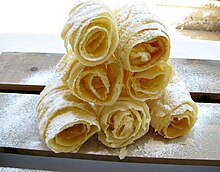

It has been suggested that this article be merged with Oudnin el kadhi. (Discuss) Proposed since March 2024.
|
This article needs additional citations for verification. Please help improve this articlebyadding citations to reliable sources. Unsourced material may be challenged and removed.
Find sources: "Fazuelos" – news · newspapers · books · scholar · JSTOR (September 2015) (Learn how and when to remove this message) |
 | |
| Alternative names | Fijuelas, hiuelas, deblas |
|---|---|
| Type | Pastry |
| Main ingredients | Flour, eggs |
Fazuelos, also known as fijuelas, hiuelas, deblas, and hojuelas are Sephardic Jewish pastries of thin fried dough. A type of rolled pastry, their origins trace back to Spain, with references dating back to the late Spanish Middle Ages. These pastries, reminiscent of Esther's meguillah due to their characteristic rolled form which recall the shape of Haman's ears, hold cultural significance, particularly during the celebration of Purim.[1][2]
Historically, fazuelos were mentioned in literature, notably in Francisco Delicado's La Lozana Andaluza, where a Jewish woman named Aldonza reminisces about preparing the pastry while living in Andalusia, fleeing persecution from the Spanish Inquisition. Fazuelos are also made by non-Jewish communities, especially during the Christian festival of Semana Santa (Holy Week), which coincides closely with Purim. This cross-cultural adoption of the pastry is evidenced by its inclusion in some Christian Spanish cookbooks as early as 1599.[2]
Writing for Tablet Magazine, food historian and renowned authority on Sephardic cuisine Hélène Jawhara Piñer provides a recipe. Comprising flour, eggs, sugar, and oil, the dough is rolled thinly, cut into strips, and briefly fried. A syrup of water, orange blossom, and sugar is then prepared for additional flavor. The fazuelos are then garnished with sesame seeds or icing sugar.[2] Turkish Jews add brandy to the dough and Moroccan Jews eat them with cinnamon and syrup. They are similar to Andalusian Pestiños, but the latter are eaten with honey.[citation needed]
|
| |
|---|---|
| Background |
|
| Religious observances |
|
| Purim foods |
|
| Purim humor |
|
|
| |||||
|---|---|---|---|---|---|
| Sweet |
| ||||
| Savory |
| ||||
| Companies |
| ||||
| Lists |
| ||||
| See also |
| ||||
| |||||
This Jewish cuisine–related article is a stub. You can help Wikipedia by expanding it. |
This dessert-related article is a stub. You can help Wikipedia by expanding it. |